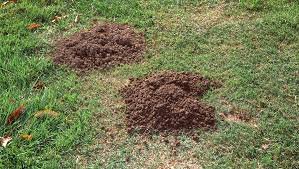
Introduction:
Spotting mysterious dirt mounds in your yard can be alarming. Proper dirt mounds in yard identification is the first step to protect your lawn and garden. Not all mounds are harmful—some, like earthworm casts, are beneficial. This guide will help you recognize the main mound-makers, understand their effects, and explore practical management strategies.
Why Animals Create Dirt Mounds in Your Yard
Animals dig for food, shelter, or nesting, and the resulting soil piles are visible as mounds. These mounds may also consist of excavated soil from burrow construction. Correct dirt mounds in yard identification allows homeowners to distinguish harmless activity from potential pests.
- Food and Shelter: Mounds result from animals seeking insects, roots, or safe burrows.
- Excavated Soil: Many mounds are simply the dirt displaced during tunneling.
Common Culprits: Dirt Mounds in Yard Identification
Earthworms (Beneficial Mound-Makers)
- Characteristics: Small, wet, pellet-like soil piles, often after rain.
- Benefits: Improve soil fertility, aerate lawns, and recycle nutrients.
- Timing: Most active in moist soil during spring and autumn.
- Tip: Earthworm mounds indicate healthy soil. Learn more from USDA Soil Health.
Moles (Subterranean Lawn Architects)
- Characteristics: Symmetrical, cone-shaped mounds with a plugged entry hole. Raised ridges may appear on the surface.
- Diet: Insects, grubs, and worms.
- Impact: Extensive tunneling may dry out grass roots and destabilize soil.
- Activity: Most active in spring and autumn mornings and evenings.
Image Suggestion: Molehill on green lawn → Alt: “Mole dirt mound in yard identification”
Learn mole control techniques.
Ants (Social Mound Diggers)
- Characteristics: Irregular, rounded, or cone-shaped mounds. Fire ants often leave no visible entry hole.
- Impact: Carpenter ants can damage wood; fire ants deliver painful stings. Many ant species are beneficial.
- Benefits: Improve soil fertility, remove pests, and even pollinate plants.
- Timing: Activity increases after rain or drought recovery.
- Ant management guide.
Gophers (Plant-Damaging Mound Makers)
- Characteristics: Fan-shaped mounds with off-center entry holes. Usually larger than mole mounds.
- Diet & Damage: Feed on roots, destroy plants, and chew wires or irrigation lines.”
- Learn more about gopher control.
Voles (Root-Feeding Mound Makers)
- Characteristics: Small, golf ball-sized exit holes. Often use mole tunnels.
- Impact: Damage roots and stems, potentially toppling plants
Raccoons and Skunks (Occasional Diggers)
- Characteristics: Uneven digging, not symmetrical mounds. Skunk holes are cone-shaped; raccoon damage covers larger areas.
- Motivation: Digging for grubs and insects, mostly nocturnal.
Wider Impact of Dirt Mounds in Yard Identification
- Aesthetic Issues: Mounds ruin lawn appearance.
- Physical Hazards: Can trip people or interfere with equipment.
- Plant Damage: Tunneling disturbs roots and soil stability.
- Structural Risks: Burrowing near foundations can cause costly repairs.
Managing Dirt Mounds: Coexistence and Control
Coexist with Beneficial Mounds
- Earthworms: Rake dry casts; tolerate activity for soil health.
- Native Ants: Knock down small hills; many species are harmless.
General Lawn Care
- Cultivate dense grass to reduce attractiveness for pests.
- Proper mowing (3+ inches) encourages deep roots.
- Deep but infrequent watering discourages surface-dwelling moles.
- Maintain garden cleanliness and remove debris.
- Fertilize and aerate regularly for healthy soil.
- Lawn care tips.
Targeted Pest Control
- Food Reduction: Treat grubs and other pest insects with nematodes or milky spore.
- Exclusion: Wire mesh around gardens for gophers and voles.
- Natural Repellents: Castor oil, peppermint oil, motion-activated sprinklers.
- Mechanical Removal: Flatten ant hills, trap moles, flood tunnels (non-fire ants).
- Predators: Birds, chickens, and woodpeckers naturally control ants and moles.
Chemical Control (Last Resort)
- Use spot treatments only.
- Options: ant baits, mole poison worms, vole baits.
- Professional pest control is recommended for severe infestations.
Learn safe pesticide use.
Conclusion:
Correct dirt mounds in yard identification helps homeowners choose the right response, whether coexistence or removal. Combining smart lawn care, natural deterrents, and mechanical control can protect your outdoor space. A thriving lawn is your best defense against unwanted pests, ensuring a healthy and beautiful yard





